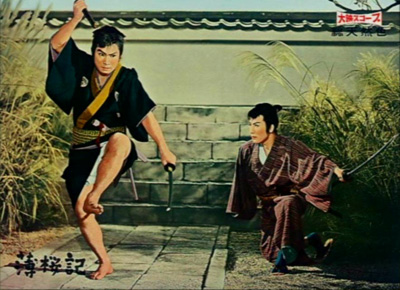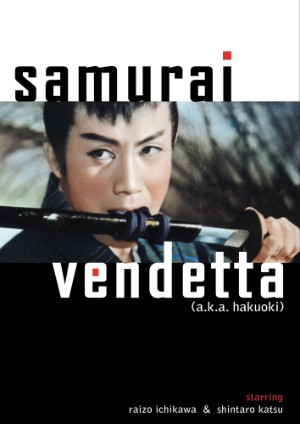 Raizo! Katsu-shin! Chushingura! Tange Sazen (sort of)! If you don't know what I'm talking about, you probably won't enjoy Samurai Vendetta (1959) as much as those who do. But that's how it goes with some samurai films: The filmmakers assume a certain amount of background knowledge on your part because, after all, you're Japanese, right? Why else would you be watching it? Surely no gaijin would be interested in this stuff. It was to remedy this cultural myopia that I originally wrote Stray Dogs & Lone Wolves and then, a few years later, Warring Clans, Flashing Blades (which includes, funnily enough, a review of Samurai Vendetta). You're welcome.
Raizo! Katsu-shin! Chushingura! Tange Sazen (sort of)! If you don't know what I'm talking about, you probably won't enjoy Samurai Vendetta (1959) as much as those who do. But that's how it goes with some samurai films: The filmmakers assume a certain amount of background knowledge on your part because, after all, you're Japanese, right? Why else would you be watching it? Surely no gaijin would be interested in this stuff. It was to remedy this cultural myopia that I originally wrote Stray Dogs & Lone Wolves and then, a few years later, Warring Clans, Flashing Blades (which includes, funnily enough, a review of Samurai Vendetta). You're welcome.And you're doubly blessed, as the good folks at AnimEigo have seen fit to release Samurai Vendetta featuring their unique brand of onscreen annotation and cultural/historical supplemental materials. Armed with an AnimEigo edition of a samurai film and my books, you're gonna be just fine.
So what's it all about? Essentially it's a love triangle between real-life samurai Horibe Yasubei (Shintaro Katsu), made-up samurai Tange Tenzin (Raizo Ichikawa) and mutual love interest Chiharu (Maki Chitose). I should point out that while I normally write Japanese names Western-style, here I've retained the Japanese form of surname first for the two male characters in order to point out the similarity between the name Tange Tenzin and Tange Sazen (the latter being the famous one-armed, one-eyed ronin character originally created by novelist Fubo Hayashi in the 1920s). Why point this out? Because Tange Tenzin is similarly mutilated over the course of the film, making me wonder what the author of the original story, Kosuke Gomi, was playing at. A one-armed swordsman named Tange? Dude, it's been done.
 Historical events such as Horibe's thrilling duel with the Murakami brothers at Takadanobaba in 1694 and the revenge of the Loyal 47 Ronin in 1702 provide a backdrop for the two men's mutual longing for Chiharu (as well as their own bromance -- being samurai, of course, they barely speak a dozen words to one another throughout the movie). Along the way, many cruel and treacherous acts are perpetrated against Tange and Chiharu. Horibe's big wound is he doesn't get the girl (that's not a spoiler -- you learn this fairly early on).
Historical events such as Horibe's thrilling duel with the Murakami brothers at Takadanobaba in 1694 and the revenge of the Loyal 47 Ronin in 1702 provide a backdrop for the two men's mutual longing for Chiharu (as well as their own bromance -- being samurai, of course, they barely speak a dozen words to one another throughout the movie). Along the way, many cruel and treacherous acts are perpetrated against Tange and Chiharu. Horibe's big wound is he doesn't get the girl (that's not a spoiler -- you learn this fairly early on).On the minus side, Raizo's swordplay, never the strongest, comes off much worse next to that of Shintaro Katsu (aka Zatoichi), particularly when Raizo's forced to play it left hand. And then there's the regrettable casting of Maki Chitose. I don't know whose cousin or niece or sister-in-law she was but frankly she's a drip, and definitely not up to the more dramatic moments of the script. So uninspiring is her performance, one wonders why the two samurai would fall so utterly for such a homely, insipid woman. Where's Masayo Banri when we need her?!
Overall, though, Samurai Vendetta is a decent film. Somewhat more melodramatic than what you're used to getting with Katsu and Raizo -- Sleepy Eyes of Death this ain't. But there's no denying this is one picture that's positively steeped in bushido, adhering to the code of the samurai to the bitter end. The original Japanese title, Hakuoki, translates as Chronicle of Pale Cherry Blossoms, a more fitting title I think. While there are plenty of vendettas to go around, the film is ultimately more concerned with the beautiful melancholy symbolized by those falling petals, that of untimely death.


2 comments:
I'll be posting my review of Samurai Vendetta next month. And I also wondered about the casting of Chitose Maki. IMDb indicates that her career was very short. When you consider the actresses around that time, established stars like Ayako Wakao, and newcomers like Mie Hama and Akiko Wakabayashi, you have to wonder what was going on at Daiei Studios. Maki even makes 38 year old Setsuko Hara look hot.
Daiei had their own bevy of beauties, three of which I call the Girls of Daiei: Masayo Banri, Shiho Fujimura and Miwa Takada. Masayo Banri, you'll recall, played Tane in the first, second, and fourth Zatoichi films. She also made an impression in Destiny's Son, helping her brother escape by whipping off her top to distract his pursuers. What a gal!
Post a Comment